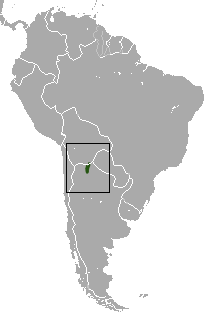Yepes's mulita facts for kids
Quick facts for kids Yepes's mulita |
|
|---|---|
 |
|
| Conservation status | |
| Scientific classification | |
| Genus: |
Dasypus
|
| Species: |
mazzai
|
 |
|
| Yepes's mulita range | |
| Synonyms | |
|
Dasypus yepesi |
|
Yepes's mulita, also known as the Yungas lesser long-nosed armadillo, is a type of armadillo. Its scientific name is Dasypus mazzai. This special animal lives only in Argentina and Bolivia. When an animal lives only in one place, we say it is endemic there. Yepes's mulita likes to live in warm, dry forests.
For a short time, this armadillo was called D. yepesi. Scientists thought it might be a different kind of armadillo. But later, they found out it was the same as D. mazzai. So, D. yepesi became a synonym, meaning it's another name for the same species.
Contents
Where Yepes's Mulita Lives
Yepes's mulita is mostly found in the Jujuy and Salta areas of Argentina. It might also live in parts of Bolivia and Paraguay. We do not have much information about this armadillo. Scientists know of fewer than ten groups of them.
These armadillos usually live in places that are 450 to 1800 meters (about 1,476 to 5,905 feet) above sea level. Their homes can be very different, from dry deserts to wet forests.
How People Use Yepes's Mulita
Some local people hunt Yepes's mulita for food.
Protecting Yepes's Mulita
Scientists do not know much about Yepes's mulita. Because of this, the IUCN lists it as "Data Deficient." This means we need more information to know how well it is doing.
The places where these armadillos live are shrinking because of deforestation. This means forests are being cut down. Their homes are also becoming "fragmented," which means they are broken into smaller, separate pieces. This makes it harder for the armadillos to find food and mates.
To help protect them, some areas have been made into special parks. These include Parque Nacional Calilegua and Parque Nacional El Rey in northern Argentina.
See also
 In Spanish: Mulita de Yepes para niños
In Spanish: Mulita de Yepes para niños


